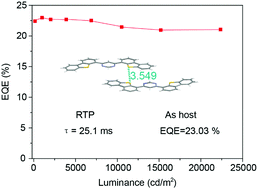当前位置:
X-MOL 学术
›
J. Mater. Chem. C
›
论文详情
Our official English website, www.x-mol.net, welcomes your feedback! (Note: you will need to create a separate account there.)
D–A–D-type bipolar host materials with room temperature phosphorescence for high-efficiency green phosphorescent organic light-emitting diodes
Journal of Materials Chemistry C ( IF 6.4 ) Pub Date : 2019/12/16 , DOI: 10.1039/c9tc04954a Fei Wang 1, 2, 3, 4, 5 , Jing Sun 4, 6, 7, 8 , Mingli Liu 4, 5, 9, 10 , Huifang Shi 4, 5, 9, 10 , Huili Ma 4, 5, 9, 10 , Wenpeng Ye 4, 5, 9, 10 , Hua Wang 4, 6, 7, 8 , Hongmei Zhang 1, 2, 3, 4 , Zhongfu An 4, 5, 9, 10 , Wei Huang 1, 2, 3, 4, 5
Journal of Materials Chemistry C ( IF 6.4 ) Pub Date : 2019/12/16 , DOI: 10.1039/c9tc04954a Fei Wang 1, 2, 3, 4, 5 , Jing Sun 4, 6, 7, 8 , Mingli Liu 4, 5, 9, 10 , Huifang Shi 4, 5, 9, 10 , Huili Ma 4, 5, 9, 10 , Wenpeng Ye 4, 5, 9, 10 , Hua Wang 4, 6, 7, 8 , Hongmei Zhang 1, 2, 3, 4 , Zhongfu An 4, 5, 9, 10 , Wei Huang 1, 2, 3, 4, 5
Affiliation

|
Bipolar host materials with donor (D)–acceptor (A) structures play an important role in high-efficiency phosphorescent organic light emitting diodes (PhOLEDs) owing to the excellent carrier transport capability, which can be optimized by a tight and regular packing mode in the molecular aggregation. Notably, this arrangement is also beneficial for enhancing intersystem crossing channels and reducing the non-radiative transition for realizing room temperature phosphorescence (RTP). On this basis, RTP materials with a rigid packing mode as the host could be utilized to prepare high-quality devices. Herein, we design and synthesize two bipolar D–A–D molecules constructed by utilizing pyrimidine as an acceptor unit, and dibenzothiophene and dibenzofuran as the donor units, named MDBT and MDBF, respectively, exhibiting considerable RTP performance. In particular, MDBT possesses a longer phosphorescence lifetime (25.1 ms) than MDBF (4.9 ms). From the single crystal analysis, MDBT has a relatively planar configuration through the intramolecular S–N bond. Meanwhile, it is arranged in a compact mode due to the presence of S–S, C–H⋯S and S–π bonds, which suppress the molecular vibration and rotation. Moreover, the rigid structure of MDBT is also certified to be conducive to the formation of a nanoscale high-quality film and charge transport. Significantly, the MDBT-based device doped with 8 wt% Ir(ppy)2(acac) exhibits a very low turn-on voltage (2.7 V) and a high electroluminescence efficiency (85.00 cd A−1, EQE = 23.03%). Even at the practical luminance of 5000 cd m−2, the efficiencies remain high (81.09 cd A−1, EQE = 21.97%), making MDBT a promising candidate as the host material for green PhOLEDs.
中文翻译:

具有室温磷光的D–A–D型双极主体材料,用于高效绿色磷光有机发光二极管
具有出色的载流子传输能力,具有施主(D)-受主(A)结构的双极性主体材料在高效磷光有机发光二极管(PhOLED)中起着重要作用,可以通过紧密和规则的填充方式来优化载流子传输能力。分子聚集。显着地,该布置还有利于增强系统间交叉通道并减少用于实现室温磷光(RTP)的非辐射跃迁。在此基础上,以刚性包装模式为主体的RTP材料可用于制备高质量的设备。在本文中,我们设计并合成了两个以嘧啶为受体单元,以二苯并噻吩和二苯并呋喃为供体的双极性D–A–D分子,分别称为MDBT和MDBF。分别具有可观的RTP性能。特别是,MDBT具有比MDBF(4.9 ms)更长的磷光寿命(25.1 ms)。从单晶分析来看,MDBT通过分子内的S–N键具有相对平面的构型。同时,由于存在S–S,C–H⋯S和S–π键,它以紧凑的方式排列,从而抑制了分子的振动和旋转。此外,MDBT的刚性结构也被证明有助于形成纳米级高质量薄膜和电荷传输。值得注意的是,基于MDBT的器件掺杂了8 wt%的Ir(ppy)2(acac)表现出非常低的开启电压(2.7 V)和高电致发光效率(85.00 cd A -1,EQE = 23.03%)。即使在5000 cd m -2的实际亮度下,效率仍然很高(81.09 cd A -1,EQE = 21.97%),这使MDBT成为绿色PhOLED的主体材料很有希望的候选者。
更新日期:2020-02-12
中文翻译:

具有室温磷光的D–A–D型双极主体材料,用于高效绿色磷光有机发光二极管
具有出色的载流子传输能力,具有施主(D)-受主(A)结构的双极性主体材料在高效磷光有机发光二极管(PhOLED)中起着重要作用,可以通过紧密和规则的填充方式来优化载流子传输能力。分子聚集。显着地,该布置还有利于增强系统间交叉通道并减少用于实现室温磷光(RTP)的非辐射跃迁。在此基础上,以刚性包装模式为主体的RTP材料可用于制备高质量的设备。在本文中,我们设计并合成了两个以嘧啶为受体单元,以二苯并噻吩和二苯并呋喃为供体的双极性D–A–D分子,分别称为MDBT和MDBF。分别具有可观的RTP性能。特别是,MDBT具有比MDBF(4.9 ms)更长的磷光寿命(25.1 ms)。从单晶分析来看,MDBT通过分子内的S–N键具有相对平面的构型。同时,由于存在S–S,C–H⋯S和S–π键,它以紧凑的方式排列,从而抑制了分子的振动和旋转。此外,MDBT的刚性结构也被证明有助于形成纳米级高质量薄膜和电荷传输。值得注意的是,基于MDBT的器件掺杂了8 wt%的Ir(ppy)2(acac)表现出非常低的开启电压(2.7 V)和高电致发光效率(85.00 cd A -1,EQE = 23.03%)。即使在5000 cd m -2的实际亮度下,效率仍然很高(81.09 cd A -1,EQE = 21.97%),这使MDBT成为绿色PhOLED的主体材料很有希望的候选者。



























 京公网安备 11010802027423号
京公网安备 11010802027423号